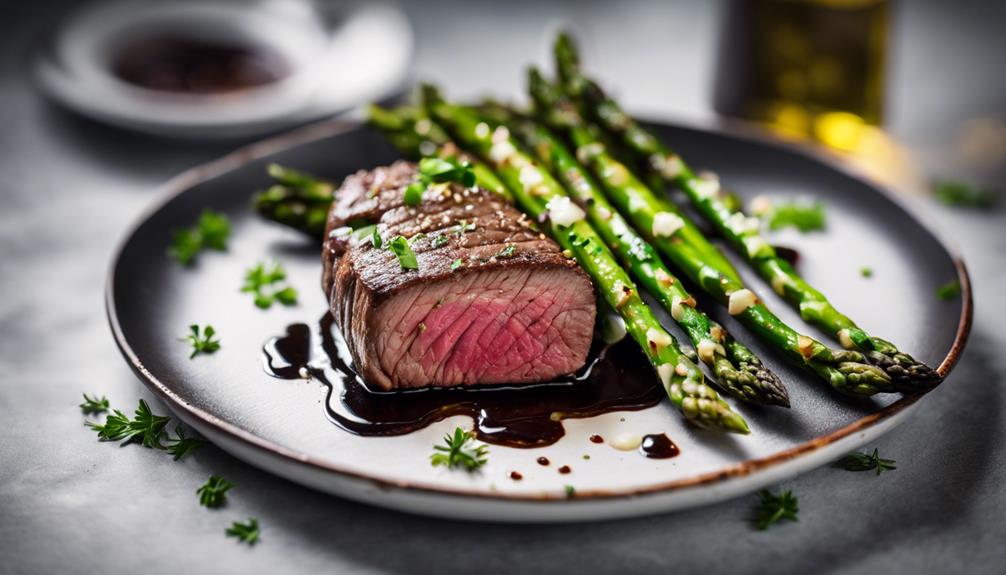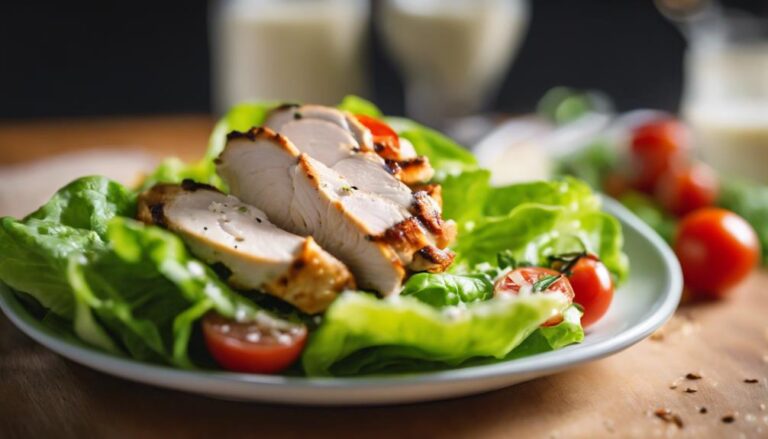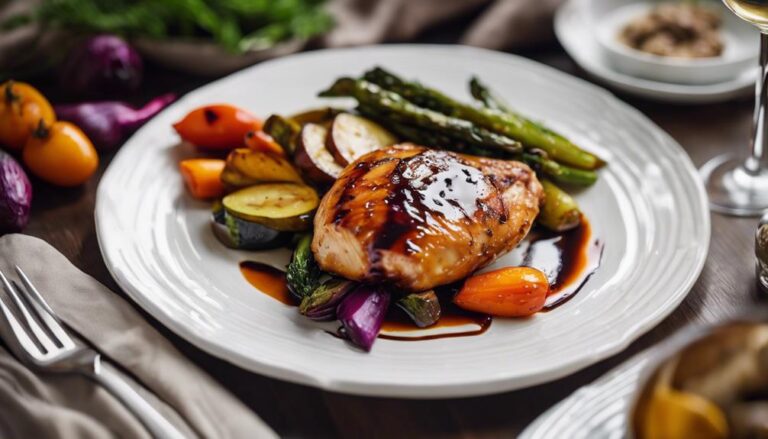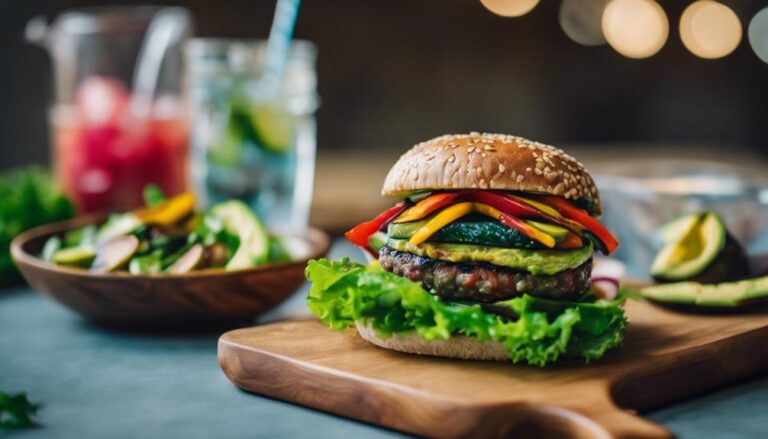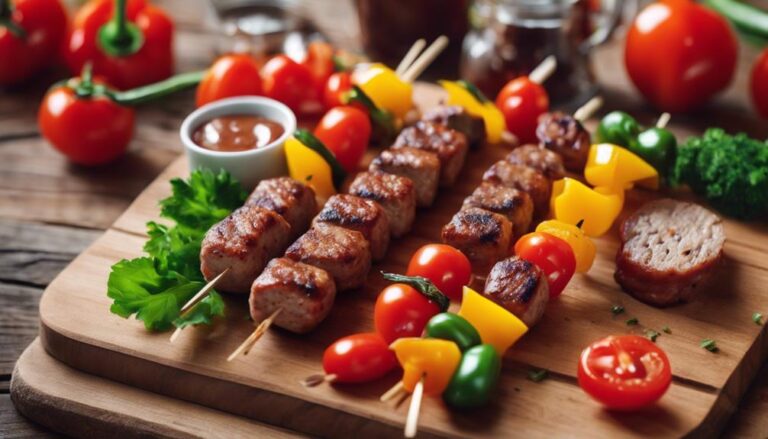Sous Vide Beef Tenderloin With Asparagus: a Gourmet 5 Factor Diet Dinner
Create a gourmet 5 Factor Diet dinner with Sous Vide Beef Tenderloin and Asparagus. Select top-quality tenderloin and fresh asparagus for this savory meal. Enhance flavors by experimenting with herb blends and a tasty marinade. Set the sous vide to 130°F for medium-rare beef. Quick sear the beef to perfection on a hot skillet. Rest the beef for even juiciness. Learn searing techniques that elevate the flavor through the Maillard reaction. Keep exploring to master this culinary delight of sous vide cooking for a satisfying and nutritious dinner.
What You Will Learn Here
- Sous vide cooking ensures precise doneness for a gourmet meal.
- High-quality beef tenderloin and fresh asparagus are essential ingredients.
- Searing at 400-450°F enhances flavor through the Maillard reaction.
- Resting the beef after cooking allows for even juice distribution.
- Store leftover sauce in the refrigerator for up to 3 days for easy reheating.
Sous Vide Cooking Origins

Sous Vide cooking has a rich history that dates back to the 18th century, originating in France. This culinary technique involves cooking vacuum-sealed food in a water bath at precise temperatures for extended periods.
While initially a method used in professional kitchens, modern advancements have made Sous Vide cooking accessible for home chefs looking to achieve restaurant-quality dishes.
Sous Vide History
The origins of sous vide cooking can be traced back to the late 18th century when scientists began exploring the concept of cooking food in vacuum-sealed containers. This historical development laid the foundation for the sous vide technique understood today. Sous vide benefits from precise temperature control, ensuring that food retains its moisture and flavors while cooking slowly over an extended period.
Over the years, sous vide has evolved from its scientific roots to become a popular culinary method recognized for producing consistently delicious results. This method gained traction in the culinary world for its ability to cook food to perfection, making it a favorite among chefs and home cooks alike.
The precision and control offered by sous vide cooking have revolutionized the way many dishes are prepared, elevating the dining experience for those who value quality and taste in their meals. As you explore the history of sous vide, you'll appreciate the innovation and dedication that have shaped this cooking technique into a culinary art form.
French Culinary Technique
Originating in France, the culinary technique of sous vide cooking has a rich history that dates back to the late 18th century. This method, deeply rooted in French culinary techniques, revolutionized gourmet cooking by enabling chefs to achieve precise temperatures and retain the natural flavors and textures of ingredients.
In gourmet cuisine, sous vide offers numerous benefits. By sealing food in airtight bags and cooking it in a water bath at controlled temperatures, this technique guarantees uniform doneness throughout the dish, resulting in tender and flavorful meals.
The gentle cooking process preserves the integrity of the ingredients, enhancing their taste and quality. French chefs have long utilized sous vide to elevate their dishes, showcasing the exquisite flavors and textures that this method produces.
For those who appreciate the art of cooking and serving others, mastering sous vide can elevate your culinary skills to new heights, allowing you to create restaurant-quality meals in the comfort of your own kitchen.
Modern Home Applications
Exploring the modern applications of this culinary technique in home kitchens reveals its transformation from a professional chef's tool to a popular method for home cooks. With recent home innovations in cooking technology, sous vide has become more accessible, allowing you to create restaurant-quality dishes in the comfort of your own kitchen. The precision and consistency provided by sous vide cooking equipment make it an attractive option for those who enjoy serving others with perfectly cooked meals.
Home innovations in sous vide cooking technology have simplified the process, making it user-friendly for amateur chefs. The precise temperature control guarantees that your food is cooked to perfection every time, whether you're preparing a tender beef tenderloin or delicate asparagus spears. With these cooking tools, you can impress your guests with gourmet dishes without the worry of traditional cooking methods.
Incorporating sous vide into your culinary repertoire highlights your commitment to mastering new cooking techniques and delivering exceptional meals to those you serve.
Key Recipe Components
Consider selecting high-quality beef tenderloin and fresh asparagus to guarantee the best results in your sous vide recipe. To elevate your dish and impress your guests, pay attention to the following key recipe components:
- Seasoning: Experiment with different herb and spice blends to enhance the flavor of the beef tenderloin. Garlic, rosemary, thyme, and black pepper are popular choices.
- Marinade: Create a savory marinade using ingredients like soy sauce, balsamic vinegar, honey, and Dijon mustard to add depth to the beef's taste.
- Cooking Time: For a perfect medium-rare beef tenderloin, set your sous vide machine to 130°F (54°C) and cook for 2-3 hours.
- Asparagus Preparation: Before adding asparagus to the sous vide bag, blanch them in boiling water for a minute and then shock them in an ice bath to retain their vibrant color and crispness.
Top-Rated Beef Tenderloin Recipes
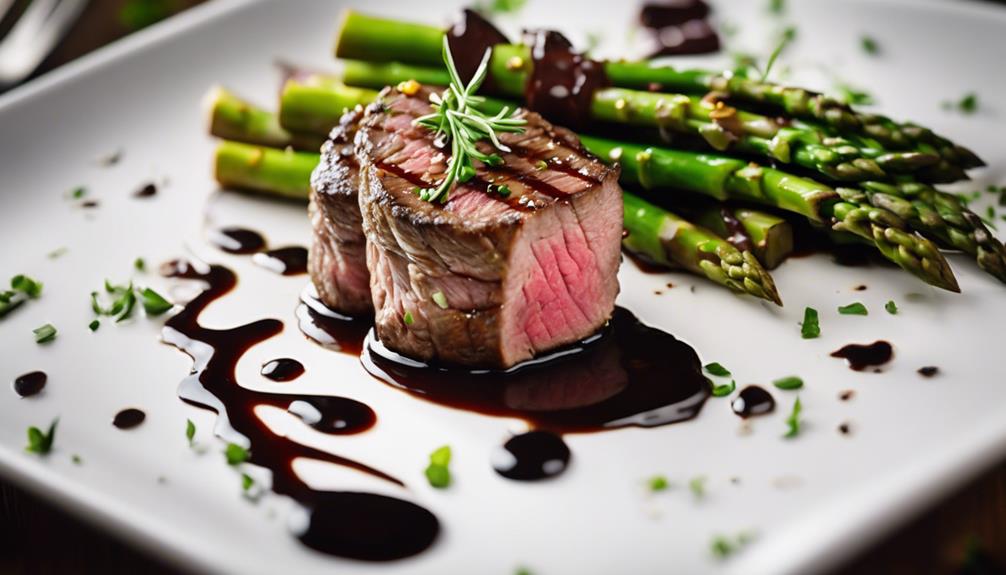
Explore top-rated beef tenderloin recipes that are sure to impress your taste buds.
Try the tenderloin sous vide recipe for perfectly cooked meat every time, accompanied by a unique asparagus side dish that adds a delightful crunch.
Don't forget to elevate your dish with a creamy mushroom sauce recipe that brings a rich and savory element to the meal.
Tenderloin Sous Vide Recipe
For a delightful and tender beef tenderloin experience, try preparing it using the sous vide cooking method. Sous vide offers several benefits that can enhance your culinary skills.
Here are some cooking tips to help you achieve the perfect sous vide beef tenderloin:
- Precise Temperature Control: Set the sous vide machine to the desired temperature for your preferred level of doneness.
- Extended Cooking Times: Allow the beef tenderloin to cook for a prolonged period to guarantee maximum tenderness and flavor infusion.
- Sealing in Juices: Vacuum-seal the beef tenderloin in a bag before placing it in the sous vide water bath to preserve its natural juices.
- Searing for Texture: After sous vide cooking, give the beef tenderloin a quick sear in a hot pan to create a delicious crust while keeping the inside tender and juicy.
Unique Asparagus Side Dish
Enhance your top-rated beef tenderloin meal with a unique asparagus side dish that complements the flavors of the succulent meat perfectly. When it comes to serving others, a well-thought-out side dish can elevate the dining experience to new heights.
Try these delightful options with your beef tenderloin:
- Roasted asparagus: Toss the asparagus spears with olive oil, salt, and pepper, then roast them in the oven until they're tender and slightly crispy. The caramelization adds a depth of flavor that pairs wonderfully with the tender beef.
- Grilled asparagus: Fire up the grill and cook the asparagus until they've a slight char, bringing out their natural sweetness. The smoky flavor from grilling complements the richness of the beef, creating a perfect balance of tastes.
- Asparagus Parmesan: Sprinkle grated Parmesan cheese over roasted asparagus for a savory umami kick that enhances the overall dish.
- Lemon garlic asparagus: Sauté asparagus with minced garlic and a squeeze of fresh lemon juice for a zesty and aromatic side that brightens up the meal.
Creamy Mushroom Sauce Recipe
Indulge in the velvety richness of a creamy mushroom sauce that perfectly complements the top-rated beef tenderloin recipes. Elevate your dining experience with this luxurious sauce that adds a burst of flavor to your tenderloin dish.
Here are some tips to enhance your culinary skills:
- Creamy mushroom sauce variations, pairing options: Experiment with different types of mushrooms like cremini or shiitake to create unique flavor profiles. Pair your sauce with roasted vegetables or creamy mashed potatoes for a delightful combination.
- Mushroom sauce serving suggestions: Serve the sauce warm over your perfectly cooked beef tenderloin for the best taste. Drizzle it generously or serve it on the side for dipping.
- Storage tips: Store any leftover sauce in an airtight container in the refrigerator for up to 3 days. Reheat gently on the stovetop, adding a splash of broth to revive the creamy texture.
Impress your guests with this delectable creamy mushroom sauce that will take your beef tenderloin to the next level.
Searing the Beef Properly
To guarantee a perfect sear on your beef tenderloin, start by preheating your skillet over medium-high heat to the ideal searing temperature.
Searing time and technique are vital; a quick sear on all sides will lock in the juices and develop a flavorful crust.
Ideal Searing Temperature
To achieve the perfect sear on your beef tenderloin, make sure the pan reaches a high temperature of 400-450°F. This temperature range is ideal for creating a beautiful crust on the outside of the meat while still keeping the inside tender and juicy.
When searing, follow these searing tips for ideal doneness and flavor development through the Maillard reaction.
The high heat of 400-450°F is essential for caramelizing the natural sugars in the meat, enhancing its flavor profile. This process, known as the Maillard reaction, creates those savory, mouthwatering compounds that make your beef tenderloin irresistibly delicious.
Searing Time and Technique
For best results when searing your beef tenderloin, make sure that the pan is preheated to a temperature of 400-450°F. Searing techniques play an essential role in enhancing the flavor of your tenderloin. A hot pan helps create a beautiful caramelized crust on the outside while keeping the inside tender and juicy.
When searing, aim for around 1-2 minutes per side to achieve a perfect medium-rare doneness.
Marinade options can also elevate the taste of your beef. Consider marinating your tenderloin before searing to add depth and complexity to the flavor profile. Common marinade ingredients include garlic, herbs, and soy sauce.
Experiment with different combinations to find your favorite flavor profile.
Importance of Resting
Resting your seared beef tenderloin is vital to allow the juices to redistribute evenly, guaranteeing a moist and flavorful final dish. Resting benefits your beef by giving the fibers time to relax, preventing the juices from escaping when you cut into the meat.
After searing, transfer the beef to a cutting board, tent it loosely with foil, and let it rest for about 10 to 15 minutes. This waiting period allows for the carry-over cooking to finish and the internal temperature to stabilize, resulting in a juicy and tender steak.
The best timing for resting your beef is optimal. If you slice the meat too soon, the juices will spill out onto the cutting board, leaving the steak dry. On the other hand, waiting too long can lead to lukewarm meat.
Aim to rest the beef for just the right amount of time to reap the full benefits of your sous vide cooking process. By following this simple step, you ensure that your beautifully seared beef tenderloin remains succulent and delightful for your dining pleasure.
Final Thoughts

As you reflect on the delightful flavors and tender texture of the sous vide beef tenderloin and asparagus, consider the simplicity and elegance of this dish.
The dietary benefits of sous vide cooking guarantee that your beef retains its nutrients without sacrificing taste or tenderness.
The flavorful combinations of the beef tenderloin and asparagus create a harmonious balance on your plate, providing a satisfying meal that's both delicious and nutritious.
When preparing this gourmet 5 Factor Diet dinner for your loved ones or guests, remember the care and precision that goes into each step of the sous vide process.
From seasoning the beef to perfectly cooking the asparagus, every detail contributes to the overall quality of the dish.
Frequently Asked Questions
Can I Use a Regular Pot for Sous Vide Cooking?
Yes, you need proper equipment for sous vide cooking to guarantee precise temperature control. Regular pots lack the benefits and accuracy of dedicated sous vide tools. To master sous vide techniques effectively, invest in the right gear.
How Can I Prevent Overcooking the Beef Tenderloin?
To guarantee a perfectly cooked tenderloin, set the sous vide temperature according to your desired doneness. Timing is key; follow a precise cooking time for that melt-in-your-mouth experience. Enjoy serving flawless beef!
What Are Alternative Searing Methods for the Beef?
When considering alternative searing methods for the beef, you can try grilling or roasting for a delicious crust. Pan searing also adds flavor, while blowtorching provides a unique finish. Experiment to find your favorite technique!
Can I Substitute Beef Tenderloin With Another Cut?
Yes, you can substitute beef tenderloin with pork tenderloin or other alternative cuts like ribeye or sirloin for sous vide. For chicken breast, consider sous vide, grilling, or pan-searing for delicious cooking options.
How Do I Store Leftover Sous Vide Beef Tenderloin?
To store leftover sous vide beef tenderloin, freeze it in airtight containers or resealable bags for up to 3 months. When reheating, use sous vide method at lower temperatures to prevent overcooking, preserving the tenderness and flavor of the meat.
Conclusion
To sum up, sous vide beef tenderloin with asparagus is a gourmet dish that can be effortlessly prepared at home. By following the essential recipe elements and properly searing the beef, you can savor a delectable and nutritious meal that aligns with the 5 Factor Diet.
This cooking technique guarantees tender, flavorful beef consistently, making it an excellent choice for a special dinner or even a weekday meal.
Indulge in the culinary adventure of sous vide cooking with this remarkable dish.
